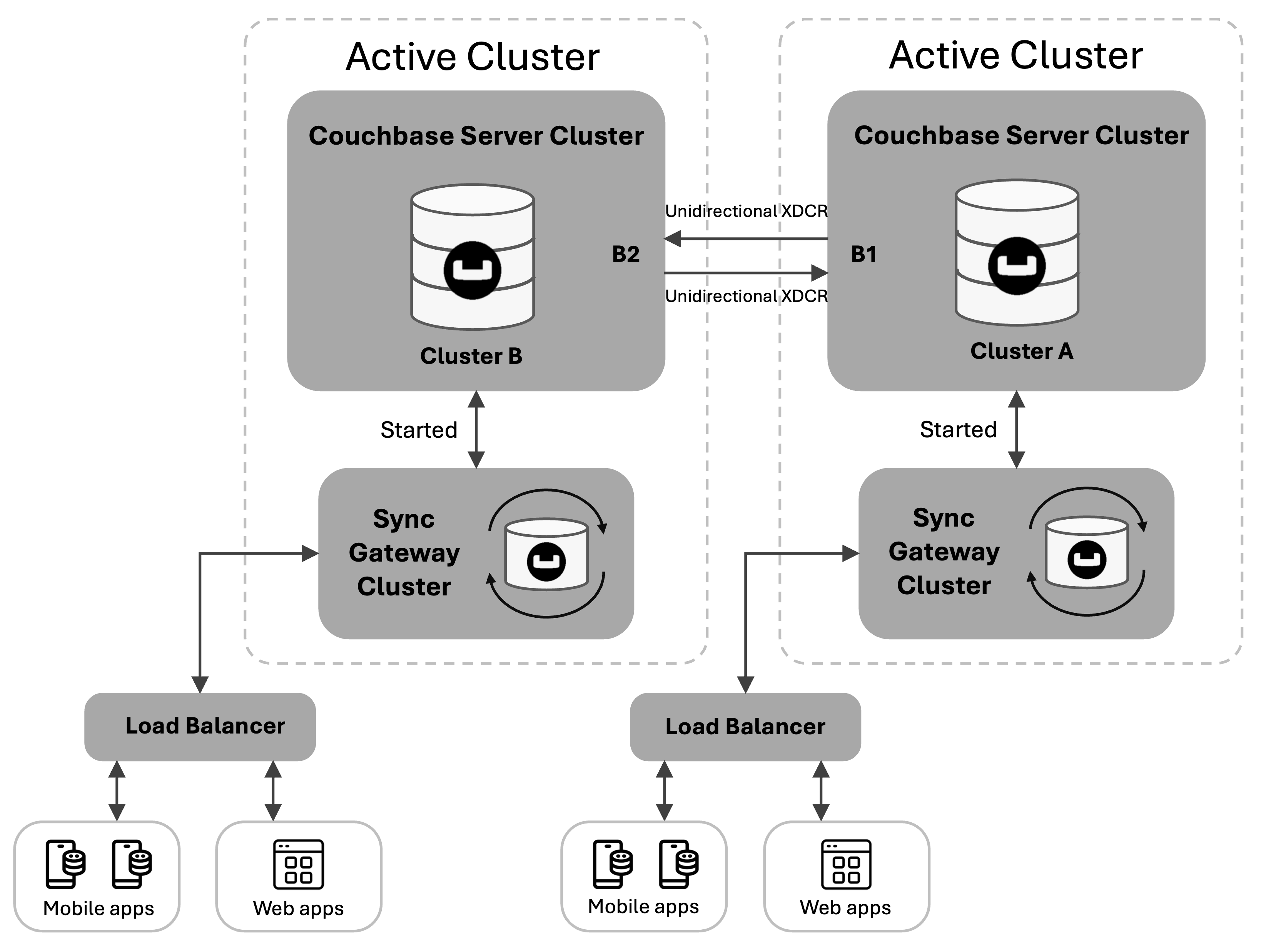XDCR Active-Active with Sync Gateway
You can use XDCR with Sync Gateway mobile clusters in a bi-directional, active-active replication, but you must make sure that both the Server and the Sync Gateway versions support this option. Otherwise, using XDCR with Sync Gateway buckets in a bi-directional replication can cause data corruption.
Introduction
| *To set up XDCR bi-directional replication with Sync Gateway (SGW), you need to have at least a Server 7.6.6 version and SGW 4.0.0 version. However, Sync Gateway 4.0.0 is a future release version. |
In the versions earlier than Server 7.6.6 and Sync Gateway (SGW) 4.0.0*, only an active-passive setup was supported with both XDCR and SGW. XDCR Active-Active replication with Sync Gateway for XDCR-Mobile interoperability configuration is introduced in the Server 7.6.6 version, where you can configure an active-active XDCR setup with Sync Gateway (SGW) and mobile applications both on the XDCR source and target clusters.
|
Here are a few limitations to the XDCR Active-Active with Sync Gateway feature.
|
You can configure XDCR Active-Active with Sync Gateway for XDCR-Mobile interoperability using one of the following methods:
-
Greenfield deployment: Set up a new active-active configuration with both XDCR and SGW.
-
Upgrading an existing setup: Convert an existing active-passive XDCR-SGW configuration to an active-active XDCR-SGW setup.
| When using the feature XDCR Active-Active with Sync Gateway, where Sync Gateway version is 4.0* or a later version and Server version is 7.6.6, the replication target XDCR inbound user must have the RBAC roles, XDCR Inbound role and Data Writer role. |
Prerequisites
Set the bucket property enableCrossClusterVersioning to use the setting mobile=Active during the processes Create a Replication and Manage XDCR.
To enable the bucket property enableCrossClusterVersioning using the REST API, see Modify the bucket property enableCrossClusterVersioning or Example: Turning on enableCrossClusterVersioning, when Editing.
Greenfield Deployment
To configure a new active-active XDCR with Sync Gateway setup, do the following:
-
Create two clusters on Server 7.6.6 or a later version with all the nodes of the clusters. For example, cluster A and cluster B (or you can upgrade the existing Server clusters to 7.6.6 or a later version).
-
Create buckets, for example, B1 and B2 in cluster A and cluster B respectively, between which XDCR will be set up. Now, do the following:
-
Enable the ECCV setting on B1. All the mutations in B1 will have a new metadata called HLV.
-
Enable the ECCV setting on B2. All the mutations in B2 will have a new metadata called HLV.
ECCV refers to the bucket property enableCrossClusterVersioning. If there are more than two buckets in the replication topology, you must enable ECCV for all those buckets.
-
-
Create an XDCR from B1 to B2 by setting
mobile=Active. Also, create an XDCR from B2 to B1 by settingmobile=Active.For information about creating an XDCR by setting
mobile=Activethrough the REST API, see Creating a Replication.For information about creating an XDCR by setting
mobile=Activefrom the UI, see Create an XDCR Replication with the UI. -
Configure SGW 4.0.0* version on each cluster, cluster A and cluster B.
This setup can handle application traffic on both buckets B1 and B2 of the respective clusters along with SGW import into both the buckets simultaneously.
Upgrading an existing setup
You can convert an existing active-passive XDCR-Sync Gateway (SGW) setup into an active-active XDCR-Sync Gateway setup.
For illustration, there are two clusters, A and B. An SGW is connected to cluster A and this cluster is active. Cluster B is passive with XDCR setup from bucket B1 in cluster A to bucket B2 in cluster B. The current application traffic should be only on bucket B1 of cluster A.

-
Upgrade both clusters A and B with all the nodes of the clusters to Server 7.6.6 or a later version.
-
Enable ECCV on bucket B1. All the mutations in B1, after this point of time, will have a new metadata called HLV.
ECCV refers to the bucket property enableCrossClusterVersioning. If there are more than two buckets in the replication topology, you must enable ECCV for all those buckets. -
Enable ECCV on bucket B2. All the mutations in B2, after this point of time, will have a new metadata called HLV.
If there are more than two buckets in the replication topology, you must enable ECCV for all those buckets. -
Update the replication settings to
mobile=Activeof the already existing XDCR from B1 to B2.You can use the REST API or the XDCR UI to update an existing replication. For information about using the REST API to modify the replication settings for an existing replication, see Change Settings for an Existing Replication to Set mobile=Active in Managing Advanced Settings.
-
Create an XDCR from B2 to B1 with the replication settings as
mobile=Active. -
Upgrade SGW on cluster A to the version 4.0.0*.
-
Connect SGW version 4.0.0* to cluster B.
-
Enable application active traffic on cluster B.
This setup can handle application traffic on both buckets B1 and B2 of the respective clusters along with SGW import into both the buckets simultaneously.
This is an illustration of the final configuration:
